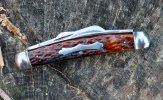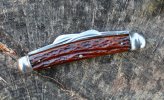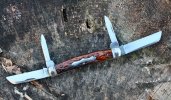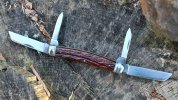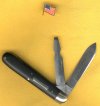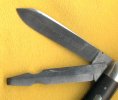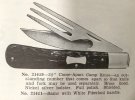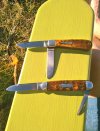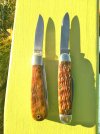I like that Remington quite a lot. It has pretty worn scales with fine color. It looks really fine folded, something I admire in a multi-blade knife. The shield is in fine alignment, something that companies like Cattaraugus did not always seem to think was all that important and evident even in their old catalogs. I can see why you liked it. It doesn't have any broken blades, which is usually a deal breaker for me when I buy a knife. If it wasn't presented to you as 100 percent original when you bought it (and old knives are rarely presented that way has been my experience) then it would not bother me. Sometimes we can take this knife collecting hobby too seriously. In the end, if you like it, then that is what matters the most. If any of you are like me, you won't ever get rich from your old or new knife collecting. If anyone gets rich (maybe Charlie's offspring

), it might be your offspring(s). But I doubt that. I know I won"t prosper from my knife fever, quite the opposite because I always want to hold on to mine. If that old Remington had a broken blade and someone repaired it with another unbroken blade (and the tang stamps appear to be the same in this case), I would, quite frankly, thank them for that, as I would not have any interest in it with a broken blade.
Here is my questionable knife contribution. Have at it. Tell me anything you want about it, just don't send me a PM and offer to take it off my hands because you won't get an answer.

The pattern stamp on this old Cattaraugus knife is stamped on the back of the clip blade as 21419. Both blades have the familiar to me Catt tang stamps and all of this in the correct font they used so many years. I cleaned it with light abrasives ( as I usually do, some get light cleaning, some get more, and I do not like metal polish or buffing a knife ) I don't normally try to get an old knife to look new, just better to my eye, and it is my eye that matters most. I understand that some don't mind cleaning and some do. I won't discuss that with you because I have been offered 2 or 3 times, in some cases, what I paid for a knife after I cleaned it up.
Right away and before I bought this knife, I knew the pattern stamp was not correct. I questioned (to myself) that the clip might not be original to the knife. There was nothing in the description from the seller that made any claim of being original either. The pattern number 2 means two blades, followed by 1 should mean one bolster, followed by model number 41 which can mean diner's knife/or teardrop jack, followed by 9, which means bone. So the second number is wrong because it definitely has two bolsters. The worm groove bone on both sides is original to the knife and it is apparent to me that the scales have never been damaged or replaced, and have the original small hammered pins. None of the bolsters show under magnification that this knife has ever been taken apart. If it has been, they did a mighty fine job. No flat spots from pin filing, nothing visible around the hinge pin. The blades open and shut smoothly, chink on the half stops, and both open to a proper and very nice angle. Aside from the pattern number being wrong and the clip being unusual for this type of knife, it is a very finely operating knife, on top of being handsome. I would not sell it and like it a lot.
I think it might have been a pattern 2269, which was pictured in my older Catt catalog as being 4" with long pen in front of the spear blade. The profile and look of the pattern of my 4" knife matches that. In either of my Catt catalogs, there is no pattern number 21419. I think the knife could have had a pen in front of the spear and maybe the pen got broken, then a highly skilled cutler placed the spear in front of the clip blade. If this was the case, it was done in it's early years, as apparent when looking down in the liners and from the spring end. It could be a lunchbox parts knife, a parts knife, a repaired knife, or it could have never made the catalogs. I doubt the later, since the pattern stamp on the clip disputes it. They got the shield alignment perfect on this one. Anyway I look at it and regardless of it's life's encounters, I love the knife.
Tell me what you think if you want to give it a go !

This one would make a fine rabbit skinner.
View attachment 1746214
View attachment 1746215
View attachment 1746217
